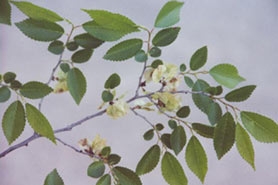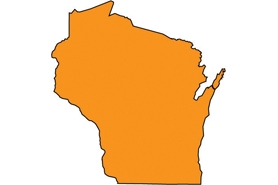Siberian elm
(Ulmus pumila)
A fast-growing tree that grows to be 50-70' tall. The bark is gray-brown bark with furrows at maturity. Twigs and leaves are nearly hairless, with black hairs on the bud scales.
Other names for this plant include:
- Common names: little leaf elm, dwarf elm
- Scientific names: Ulmus campestris var. pumila; U. manshurica; U. turkestanica
Classification in Wisconsin: Restricted (hybrids and individuals used as a rootstock are exempt)
- Ecological Threat
-
- Tolerates various growing conditions including extreme temperatures, nutrient-poor soils and low moisture.
- It can be found along roadsides, pastures, grasslands, stream banks, and prairies.
- Due to seeds' fast development and germination, dense thickets form rapidly, displacing native vegetation and reducing forage for native fauna.
- Identification
-
Leaves: Small (0.8-2.6" long), alternate, elliptical, smooth, singly-toothed leaves. The base of the leaves is tapered or rounded. Leaves can be slightly hairy when young. Mature leaves are dark green and smooth above, pale and nearly hairless on the underside.
Flowers: Greenish, lack petals, and occur in small drooping clusters of 2-5. Flowers appear in spring before leaves unfold.
Fruits & seeds: Flat, circular, winged fruit (samaras) are deeply notched at the tip and contain one circular seed with a smooth surface, about ½" comprehensive. Fruits develop quickly and are dispersed by the wind. Seeds germinate quickly.
Similar species: American elm (Ulmus americana) and slippery elm (U. rubra) have twice-serrate leaves that are over 2.8" long and are asymmetrical at the base of the leaf. Chinese elm (Ulmus parviflora) flowers in late summer or fall and the apex and teeth of leaves are less sharply acute.
- Control
- Mechanical:
- Pull seedlings by hand; Small trees can be removed with a hoe or a weed wrench.
- Fire can also be used in fire-adapted communities to control small trees that are only a few years old.
- Girdling the trees in late spring to mid-summer when the bark peels away from the sapwood easily and the sap is flowing causes the tree to die slowly over a few years and will not stimulate resprouts. The bark must be removed just outside the wood; if the tree is cut too deep, it will resprout.
- Glyphosate may be used for cut-stem treatments and can be done in the fall or winter.
- Resources
- Sources for content:
- Czarapata, Elizabeth; Invasive Plants of the Upper Midwest: an illustrated guide to their identification and control. The University of Wisconsin Press. 2005. Pg. 96-97



